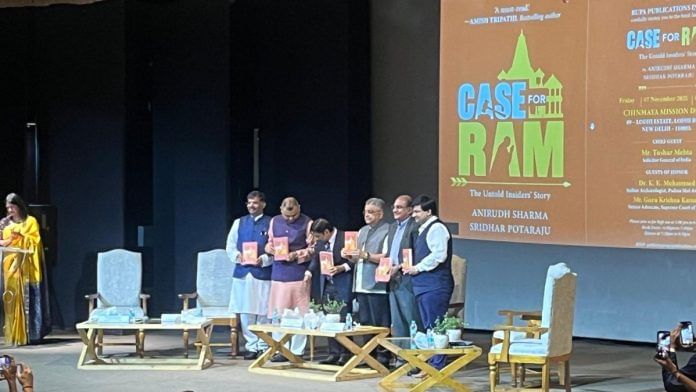New Delhi: Amid lawyers swooning over the guest of honour, Solicitor General Tushar Mehta, Anirudh Sharma and Sridhar Potaraju’s Case for Ram—the story of the Ram Janmabhoomi Case—was launched at the Chinmaya Mission in Delhi before a packed house. Also present were archaeologist KK Muhammed and senior advocate Guru Krishna Kumar.
The launch was an elaborate one, with tea and snacks served even before the actual event started. This was followed by an elaborate dinner, attended by a crowd running into the hundreds.
Advocates and archaeologists present in the auditorium went back in time to recall the atmosphere in the courtroom through the two decades of the case, when the environment outside was highly polarised.
“This is a case which had gone beyond the courtrooms, it is a case which went way beyond discussions in circles or social media, it defined how the legal system of this country would go on to handle a case of this nature, and it is very important for the future generations to know how this case unfolded in court,” said Guru Krishna Kumar.
At the beginning of the event, the panellists tried to explain the Hindu-Muslim polarisation that the Janmabhoomi case caused. According to them, the polarity outside did not permeate the walls of the courtroom.
Rising from his chair, archaeologist Muhammed said that the “Ram Janmabhoomi is as important to Hindus as Mecca, Medina is to the Muslims.” The room erupted with applause.
Also read: 6th century Brahmin who took Buddhism to China—his DNA analysis rewrites Silk Road history
The case diary
The guests touted the book for being objective, calling it lucid and praising it for its story-like writing style, making it accessible for readers without a law background.
“By reading this book, many of you will understand how to write about legal matters in an engaging way,” said Rupa Publication’s legal head, Dipankar Ghosh.
Case for Ram talks about the material gathered for researching the Janmabhoomi case, the kind of materials referred to, and the arguments made. It also captures courtroom action.
When moderator Mehra asked Potaraju about the most engaging chapter in the book, he recommended reading the chapter titled ‘1885’.
“During my research, I got to know there was litigation on the temple case as far back as 1885. You never get to hear such things in mainstream media. In this chapter, we bring out the history of the case,” he added.
The 1885 case was the first legal challenge to the Babri Masjid, filed by Mahant Raghubir Das in Faizabad, seeking permission to build a temple at the Ram chabutra. It marked the beginning of a prolonged battle.
The presence of Dr Eijaz Maqbool, Advocate on Record for the Muslims in the case, was duly noted by panel members.
It requires a “different kind of spirit” to attend that gathering, Mehta said.
Former Attorney General of India K Parasaran—who attended the book’s Chennai launch on 17 October—was also referred to by the panellists multiple times.
“Mr Parasaran and others argued with complete passion and devotion for the brief as well as the cause, while the other side, represented by Rajeev Dhavan—one of the best counsels in the country—presented their side with devotion toward the brief,” Mehta added. “The court treated the dispute as one of property and not temple vs mosque. Court maintained its cool and showed judicial statesmanship in the matter.”
Toward the end of the event, commentator Madhu Kishwar, during a Q&A session, stood up and spoke of Hinduphobia. She went on to demand the arrest of ‘communist historians’ who dispute the presence of temple remains at the Babri Masjid site. The appeal was met with a couple of scanty claps from the audience.
(Edited by Prasanna Bachchhav)






